目录
宏观原理
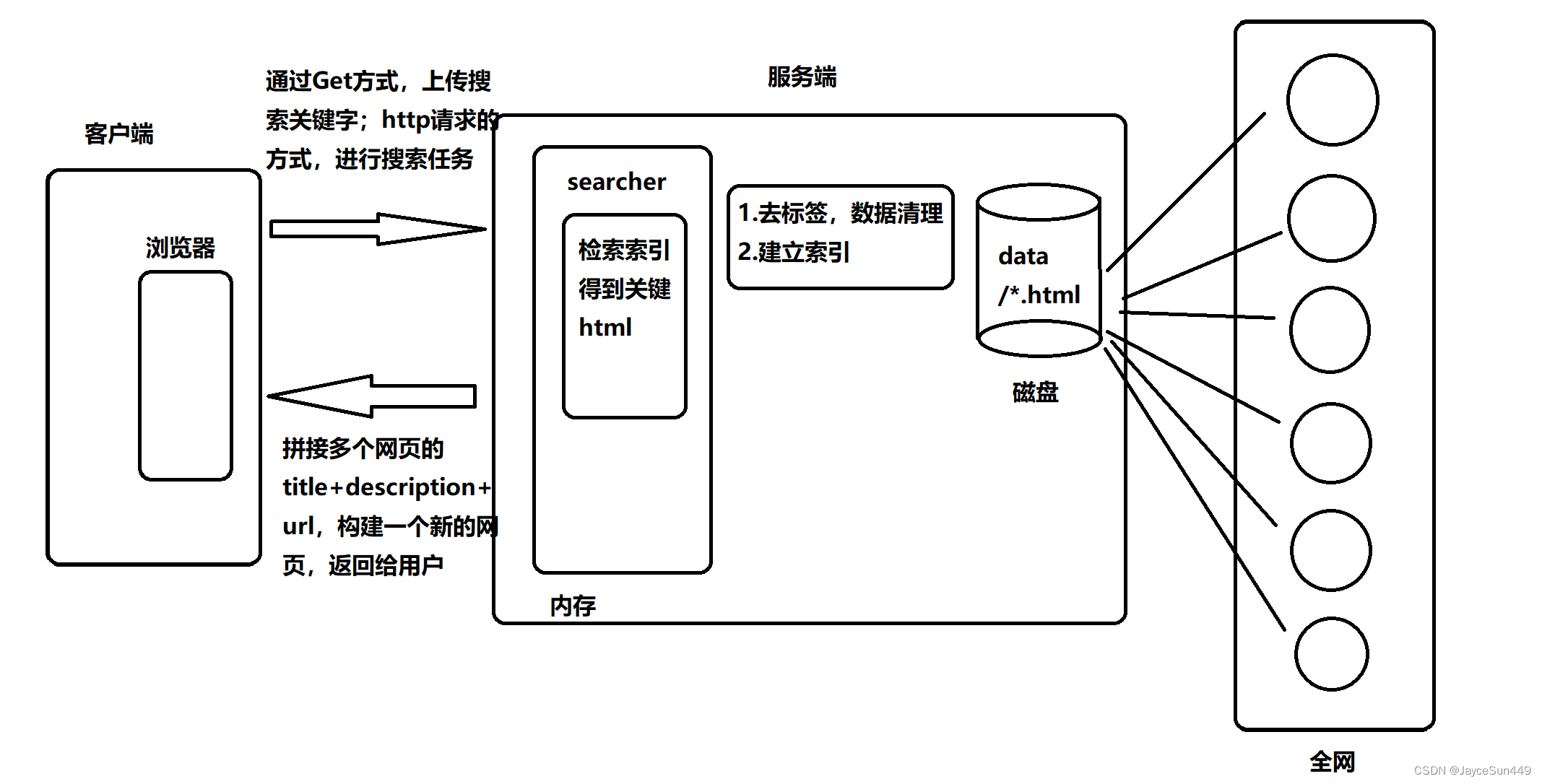
- 当我们使用搜索引擎搜索内容时,每条搜索结果一般都是由标题(title),摘要(description),网址(url)组成的,这也是本搜索引擎显示结果的模式。
- 项目实现的搜索引擎中的数据(data)来源于上图不同,不来源于全网搜集,而是通过在Boost官网下载网页数据得到。
技术栈和项目环境
- 技术栈:C/C++, C++11, STL, 转标准库Boost, Jsoncpp, cppjieba, cpp-httplib, html5 css, js, jQuery, Ajax
- 项目环境:Centos7云服务器, vim/gcc(g++)/Makefile, vscode
具体原理(正排&倒排索引)
正排索引:从文档ID找到文档内容
| 文档id | 文档内容 |
|---|---|
| 1 | 乔布斯买了两斤苹果 |
| 2 | 乔布斯发布了苹果手机 |
目标文档分词(目的:方便建立倒排索引和查找)
- 乔布斯/买/两斤/苹果/两斤苹果
- 乔布斯/发布/苹果/苹果手机
停止词:了,的,吗,a,the,一般在分词的时候不考虑
倒排索引:根据文档内容,分词整理出不重复的关键字,对应联系到文档ID的方案
| 关键字 | 文档ID |
|---|---|
| 乔布斯 | 1,2 |
| 买 | 1 |
| 两斤 | 1 |
| 苹果 | 1,2 |
| 两斤苹果 | 1 |
| 发布 | 2 |
| 苹果手机 | 2 |
模拟一次查找到过程:
用户输入:苹果->倒排索引中查找->提取出文档ID(1,2)->根据正排索引找到文档内容->title+content(description)+url文档结果进行摘要->构建响应结果
boost官网链接: https://www.boost.org/
进入官网点击download下载最新版文档


下载完成后进入项目目录,使用命令rz -E把文档传输到云服务器。

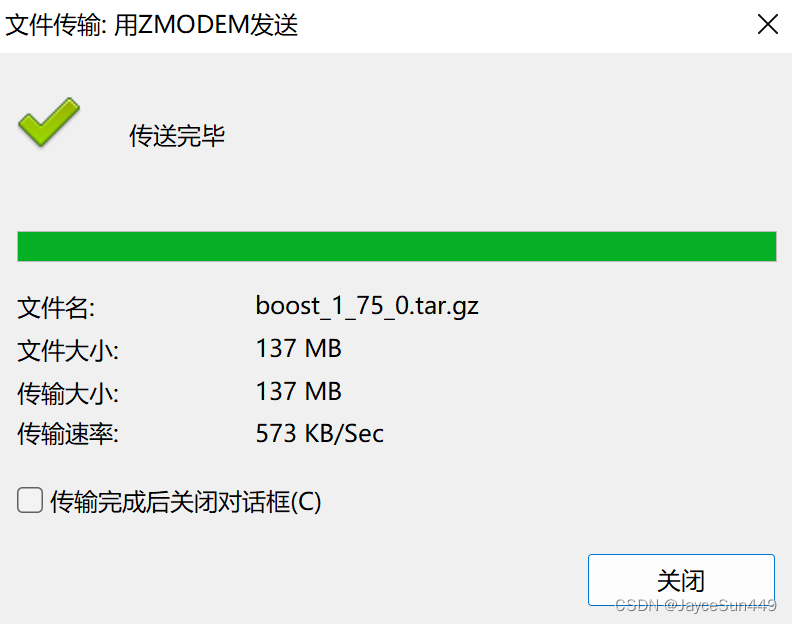
上传完成后使用tar xzf boost_1_75_0.tar.gz命令解压文件
接着使用mkdir -p data/input 命令创建目录,使用cp -rf boost_1_75_0/doc/html/* data/input/ 命令将html目录下的内容全部拷贝到input下。
编写数据去标签与数据清洗的模块parser
什么是标签?下面是笔者随意打开的一个html文件,其中被<>括住的内容就是标签。

他们对搜索没有价值,需要去掉这些标签,一般标签是成对出现的。现在返回data目录创建proccessd_html目录用来储存去完标签的数据,我们的目标是把每个文档都去标签,写入同一个文件中,并且每个文档只占一行。各文档之间用\3 进行区分
框架
// 此目录指向所有html网页
const std::string src_path = "/home/ssj/Boost/boost-search/data/input";
const std::string proc_path = "/home/ssj/Boost/boost-search/data/output/proc.txt";
typedef struct DocInfo
{
std::string title; //文档的标题
std::string content; //文档内容
std::string url; //该文档在官网中的url
}DocInfo_t;
//const& :输入
//*: 输出
//&: 输入输出
bool EnumFile(const std::string &src_path, std::vector<std::string> *file_list);
bool ParseHtml(std::vector<std::string>& file_list, std::vector<DocInfo_t> *results);
bool SaveHtml(const std::vector<DocInfo_t> &results, const std::string& proc_path);
int main()
{
std::vector<std::string> file_list;
// 第一步: 递归式的把每个html文件名及路径保存到files_list中,方便后期进行文件读取
if (!EnumFile(src_path, &file_list))
{
std:cerr << "enum file name error" << std::endl;
return 1;
}
// 第二步: 按照file_list读取每个文件的内容,并进行解析
std::vector<DocInfo_t> results;
if (!ParseHtml(file_list, &results))
{
std::cerr << "parse html error" << std::endl;
return 2;
}
//第三步:把解析完毕的各个文件内容写入proc_path中,按\3作为每个文档的分隔符
if (!SaveHtml(results, proc_path))
{
std::cerr << "Save error" << std::endl;
return 3;
}
return 0;
}
bool EnumFile(const std::string &src_path, std::vector<std::string> *file_list)
{
return true;
}
bool ParseHtml(std::vector<std::string>& file_list, std::vector<DocInfo_t> *results)
{
return true;
}
bool SaveHtml(const std::vector<DocInfo_t> &results, const std::string& proc_path)
{
return true;
}
枚举文件名
安装boost开发库
首先我们要安装boost库来方便管理文件系统,输入如下指令进行安装
sudo yum install -y boost-devel // boost开发库

因为我已经下载过Boost开发库了,因此下面提示我已经安装过

值得注意的是,目前我们已经下载了两个Boost库,其中第一个是我们用来做站内查找的,第二个则是开发库,两者并不冲突。
代码
EnumFile
bool EnumFile(const std::string &src_path, std::vector<std::string> *files_list)
{
namespace fs = boost::filesystem;
fs::path root_path(src_path); // 创建根目录
if (!fs::exists(root_path)) // 检查根目录是否存在
{
std::cerr << src_path << " not exists" << std::endl;
return false;
}
// 定义一个空的迭代器,用来判断递归结束
fs::recursive_directory_iterator end;
// 进行遍历
for(fs::recursive_directory_iterator iter(root_path); iter != end; iter++)
{
// 如果不是普通文件,就跳过
if (!fs::is_regular_file(*iter))
{
continue;
}
// 如果文件后缀不是".html",就跳过
if (iter->path().extension() != ".html")
{
continue;
}
// debug代码
std::cout << "debug: " << iter->path().string() << std::endl;
// 当前路径一定是合法的,以.html为结尾的普通网页文件
// string()可以把路径以字符串的形式返回
files_list->push_back(iter->path().string());
}
return true;
}
Makefile
cc=g++
parcer:parcer.cc
$(cc) -o $@ $^ -lboost_system -lboost_filesystem -std=c++11
.PHONY:clean
clean:
rm -rf parcer
测试结果
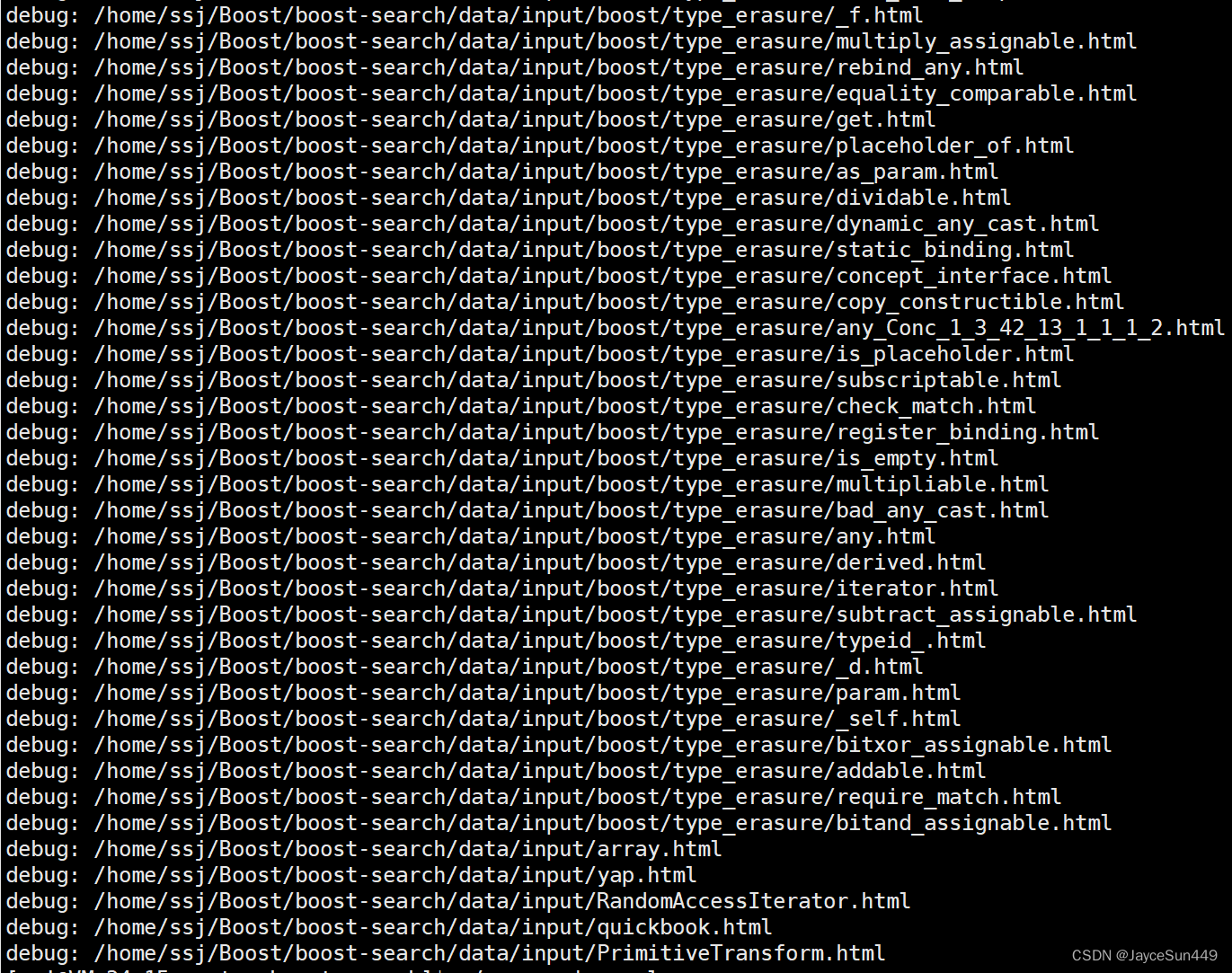
一共有7千多个html文件

解析html结构
接着我们就开始第二步,还记得在代码框架中我们所需每个条目的三个要素吗?
typedef struct DocInfo
{
std::string title; //文档的标题
std::string content; //文档内容
std::string url; //该文档在官网中的url
}DocInfo_t;
通过遍历每个文件名,依次获得他们的html结构,
bool ParseHtml(std::vector<std::string>& files_list, std::vector<DocInfo_t> *results)
{
for (const std::string& file : files_list)
{
// 1. 读取文件Read()
// 2. 提取title
// 3. 提取content
// 4. 解析指定的文件路径,构建url
}
return true;
}
接下来我们创建一个文件util.hpp专门存放工具,这一次我们编写函数来解析html结构:

随便打开一个html文件看看,其实提取内容在本质上也就是去标签。
读取文件
static bool ReadFile(const std::string &file_path, std::string *out)
{
std::ifstream in(file_path, std::ios::in);
if (!in.is_open())
{
std::cerr << "open file " << file_path << std::endl;
return false;
}
std:: string line;
while (std::getline(in, line))
{
*out += line;
}
in.close();
return true;
}
提取title
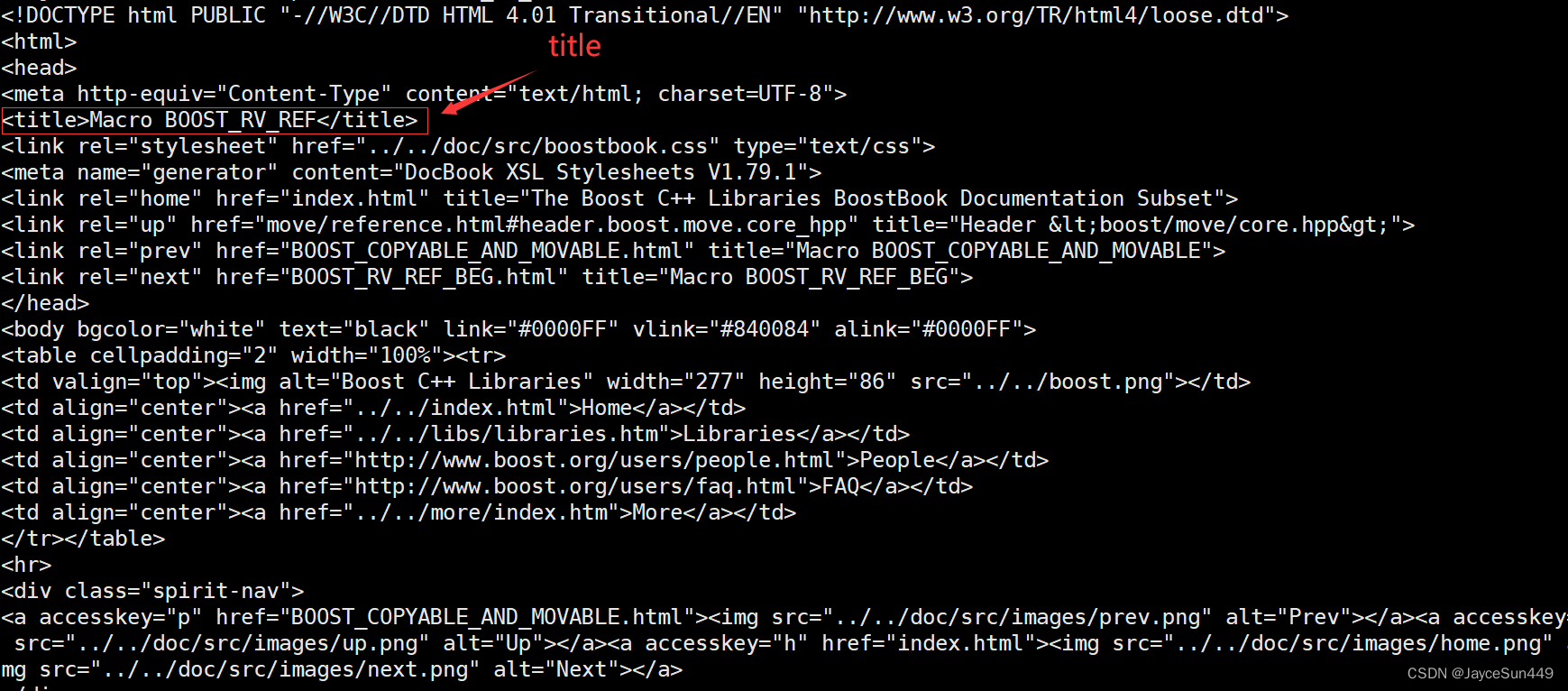
上图就是html中的title,<title>和</title>标签框住,因此可以根据这个特性用C++的find()查找。
static bool ParceTitle(const std::string &file, std::string *title)
{
// 找到title
std::size_t begin = file.find("<title>");
if (begin ==std::string::npos)
{
return false;
}
// 找到结尾
std::size_t end = file.find("</title>");
if (end == std::string::npos)
{
return false;
}
// 开始位置跳过标签
begin += std::string("<title>").size();
// 确保begin不大于end
if (begin > end)
{
return false;
}
// 提取title
*title = file.substr(begin, end - begin);
return true;
}
提取内容
static bool ParseContent(const std::string &file, std::string *content)
{
// 去标签,基于一个简易的状态机
enum status
{
LABLE,
CONTENT
};
enum status s = LABLE;
// 在遍历时,只要碰到了>,就意味着当前的标签处理完毕
for (char c : file)
{
switch (s)
{
// 当状态是LABLE的时候什么都不需要处理
case LABLE:
if (c == '>')
{
s = CONTENT;
}
break;
case CONTENT:
// 只要碰到<就代表进入标签
if (c == '<')
{
s = LABLE;
}
else
{
// 我们不想保留原始文件中的\n,因为他将来会被作为html解析之后文本的分隔符
if (c == '\n') c = ' ';
content->push_back(c);
}
break;
default:
break;
}
}
return true;
}
解析URL
这是官网中的一个url :https://www.boost.org/doc/libs/1_75_0/doc/html/boost_asio/reference/basic_socket_acceptor/basic_socket_acceptor.html
这是我放在input目录下的同一个网页的路径:/home/ssj/Boost/boost-search/data/input/boost_asio/reference/basic_socket_acceptor

static bool ParseUrl(const std::string &file_path, std::string *url)
{
std::string url_head = "https://www.boost.org/doc/libs/1_75_0/doc/html";
std::string url_tail = file_path.substr(src_path.size());
*url = url_head + url_tail;
return true;
}
EnumFile
bool ParseHtml(std::vector<std::string>& files_list, std::vector<DocInfo_t> *results)
{
for (const std::string& file : files_list)
{
// 1. 读取文件,Read()
std::string result;
// 如果无法找到文件,跳过
if (!ns_util::FileUtil::ReadFile(file, &result))
{
continue;
}
DocInfo_t doc;
// 2. 提取title
if (!ParceTitle(result, &doc.title))
{
continue;
}
// 3. 提取content,本质是去标签
if (!ParseContent(result, &doc.content))
{
continue;
}
// 4. 解析指定的文件路径,构建url
if (!ParseUrl(file, &doc.url))
{
continue;
}
// 完成解析任务,当前文档的相关结果都保存在doc
results->push_back(std::move(doc));
// Debug
//ShowDoc(doc);
}
return true;
}
测试
添加如下代码检查下结果是否正确
void ShowDoc(const DocInfo_t &doc)
{
std::cout << "title: " << doc.title << std::endl;
std::cout << "content: " << doc.content << std::endl;
std::cout << "url: " << doc.url << std::endl;
}
bool ParseHtml(std::vector<std::string>& files_list, std::vector<DocInfo_t> *results)
{
for (const std::string& file : files_list)
{
// 1. 读取文件,Read()
std::string result;
// 如果无法找到文件,跳过
if (!ns_util::FileUtil::ReadFile(file, &result))
{
continue;
}
DocInfo_t doc;
// 2. 提取title
if (!ParceTitle(result, &doc.title))
{
continue;
}
// 3. 提取content,本质是去标签
if (!ParseContent(result, &doc.content))
{
continue;
}
// 4. 解析指定的文件路径,构建url
if (!ParseUrl(file, &doc.url))
{
continue;
}
// 完成解析任务,当前文档的相关结果都保存在doc
results->push_back(std::move(doc));
// 添加此处 Debug
ShowDoc(doc);
}
return true;
}
编译代码,这里会得到非常多的数据直接Ctrl + c即可

这是其中一条结果,可以看到content中已经没有标签了,而且用url也可以正常登录网页
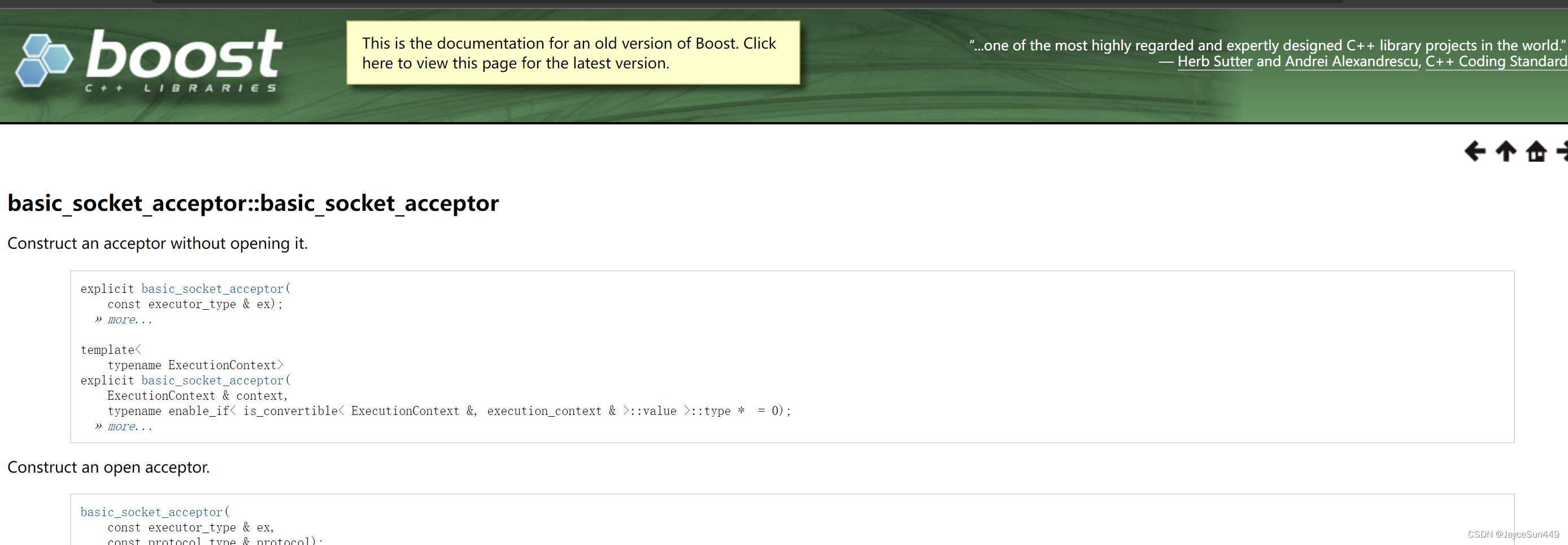
打开网页可以看到标题跟处理结果也是能对上的
写入文件
下面开始parcer.cc中的最后一步:SaveHtml()
在写入文件时需要考虑写入方便,也要考虑读取方便,在本项目中采用的是这种写入形式:
title1\3content1\3url1\ntitle2\3content2\3url2\n
这样我们可以通过getline(ifstream, line)每次读取一个网页的全部信息,并通过\3区分不同的元素。
bool SaveHtml(const std::vector<DocInfo_t> &results, const std::string& proc_path)
{
// 按照二进制方式写入
std::ofstream out(proc_path, std::ios::out | std::ios::binary);
if (!out.is_open())
{
std::cerr << "open " << proc_path << " failed" << std::endl;
return false;
}
// 就可以进行文件内容写入
for (auto &item : results)
{
#define SEP '\3'
std::string out_string;
out_string = item.title;
out_string += SEP;
out_string += item.content;
out_string += SEP;
out_string += item.url;
out_string += SEP;
out_string += '\n';
out.write(out_string.c_str(), out_string.size());
}
out.close();
return true;
}
索引
再创建一个文件:index.hpp,用来编写索引功能的代码。
框架
namespace ns_index
{
// 存储文档信息
struct DocInfo
{
std::string title;
std::string content;
std::string url;
int doc_id; // 文档的id
};
// 倒排索引元素
struct InvertedElem
{
uint64_t doc_id;
std::string word; //关键字
int weight; //权重
};
// 倒排拉链
typedef std::vector<InvertedElem> InvertedList;
// 索引类
class Index
{
private:
// 正排索引的数据结构用数组,数组的下标是文档的id
std::vector<DocInfo> forward_index; // 正排索引
// 倒排索引一定是一个关键字和一组InvetedElem对应[关键字和倒排拉链的映射关系]
std::unordered_map<std::string, InvertedList> inverted_index;
public:
forward_Index(){}
Inverted_Index(){}
public:
// 根据doc_id找到文档内容
DocInfo *GetForwardIndex(const uint64_t &doc_id)
{
if (doc_id >= forward_index.size())
{
std::cerr << "doc_id out range" << std::endl;
return nullptr;
}
return forward_index[doc_id];
}
// 根据关键字string,获得倒排拉链
InvertedList *GetInvertedList(const std::string &word)
{
auto iter = invered_index.find(word);
if (iter == inverted.end())
{
std::cerr << word << " has no InvertedList" << std::endl;
return nullptr;
}
return &iter->second;
}
// 根据文档去标签,格式化之后的文档,构建正派和倒排索引
bool BuildIndex(const std::string &input) // parse处理完毕的数据
{
std::ifstream in(input, std::ios::in | std::ios::binary);
if (!in.isopen())
{
std::cerr << "sorry, " << input << " open error" << std::endl;
return false;
}
std::string line;
while (std::getline(in, line))
{
DocInfo *doc = BuildForwordIndex(line);
if (nullptr == doc)
{
// debug
std::cerr << "build " << line << "error" << std::endl;
continue;
}
BuildInvertedIndex(*doc);
}
return true;
}
private:
// 建立正排索引
DocInfo *BuildForwardIndex(const std::string &line)
{}
// 建立倒排索引
bool BuildInvertedIndex(const DocInfo &doc)
{}
};
}
构建正排索引
DocInfo *BuildForwardIndex(const std::string &line)
{
//1. 解析line,字符串切分
std::vector<std::string> results;
std::string sep = "\3"; //行内分隔符
// 此代码在util.hpp中
ns_util::StringUtil::CutString(line, &results, sep);
if (results.size() != 3)
{
return nullptr;
}
//2. 字符串填充到DocInfo
DocInfo doc;
doc.title = results[0];
doc.content = results[1];
doc.url = results[2];
doc.doc_id = forward_index.size();//doc在vector中的下标
//3. 插入到正排索引的vector
forward_index.push_back(std::move(doc));
return &forward_index.back();
}
util.hpp中的内容
class StringUtil
{
public:
// 切分字符串
static void CutString(const std::string &target, std::vector<std::string> *out, std::string sep)
{
// 使用boost库的split()
// 需要包含头文件<boost/algorithm/string.hpp>
boost::split(*out, target, boost::is_any_of(sep), boost::token_compress_on);
}
};
构建倒排索引
// 原理
// 根据每个文档的内容,形成一个或多个InvertedElem。
struct InvertedElem
{
uint64_t doc_id;
std::string word;
int weight;
};
// 倒排拉链
typedef std::vector<InvertedElem> InvertedList;
//倒排索引一定是一个关键字和一组(个)InvertedElem对应[关键字和倒排拉链的对应关系]
1.需要对title和content分词
2.词频统计
3.自定义相关性
struct InvertedElem elem;
elem.doc_id = 123;
elem.word = word.first;
elem.weight = 10 * word.second。title_cnt + word.second.content_cnt;// 根据词频统计得出的相关性
inverted_index[word.first].push_back(elem);
下载并使用Jieba
为了分词我们需要下载Jiaba,Github链接: https://github.com/yanyiwu/cppjieba,复制仓库http地址,clone到Linux的工作目录即可。
接着为了引头文件更加方便,我们可以把重要的文件建立软链接,放到项目路径中,
在项目路径下
ln -s ~/cppjieba/include/cppjieba.hpp cppjieba (保存了库文件,包含Jieba.hpp)
ln -s ~/cppjieba/dict dict (词典,保存词条)
现在直接开始使用jieba还会出现问题,还得做这一步
cd cppjieba
cp -rf deps/limonp include/cppjieba
编写倒排索引代码
bool BuildInvertedIndex(const DocInfo &doc)
{
// DocInfo{title, content, url, doc_id}
//word->倒排拉链
struct word_cnt
{
/*储存标题,内容关键词出现用于计算权重*/
int title_cnt;
int content_cnt;
word_cnt():title_cnt(0), content_cnt(0){}
};
std::unordered_map<std::string, word_cnt> word_map; // 用来暂存词频的映射表
// 拆分标题
std::vector<std::string> title_words;
ns_util::JiebaUtil::CutString(doc.title, &title_words);
// 对标题进行词频统计
for (std::string s : title_words)
{
boost::to_lower(s); // 将分词统一转化为小写
word_map[s].title_cnt++;
}
// 拆分内容
std::vector<std::string> content_words;
ns_util::JiebaUtil::CutString(doc.content, &content_words);
// 统计内容
for (std::string s : content_words)
{
boost::to_lower(s); // 将分词统一转化为小写
word_map[s].content_cnt++;
}
#define X 10
#define Y 1
for (auto &word_pair : word_map)
{
/*InvertedElem{doc_id,word,weight}*/
InvertedElem item;
item.doc_id = doc.doc_id;
item.word = word_pair.first;
item.weight =X * word_pair.second.title_cnt + Y * word_pair.second.content_cnt; // 相关性
InvertedList &inverted_list = inverted_index[word_pair.first];
inverted_list.push_back(std::move(item));
}
return true;
}
util.hpp中的内容
const char* const DICT_PATH = "./dict/jieba.dict.utf8";
const char* const HMM_PATH = "./dict/hmm_model.utf8";
const char* const USER_DICT_PATH = "./dict/user.dict.utf8";
const char* const IDF_PATH = "./dict/idf.utf8";
const char* const STOP_WORD_PATH = "./dict/stop_words.utf8";
//将该对象设置为单例
class JiebaUtil
{
private:
// static cppjieba::Jieba jieba;
cppjieba::Jieba jieba;
std::unordered_map<std::string, bool> stop_words;
JiebaUtil():jieba(DICT_PATH, HMM_PATH, USER_DICT_PATH, IDF_PATH, STOP_WORD_PATH)
{}
JiebaUtil(const JiebaUtil&) = delete;
static JiebaUtil *instance;
public:
static JiebaUtil* get_instance()
{
static std::mutex mtx;
if (nullptr == instance)
{
mtx.lock();
if (nullptr == instance)
{
instance = new JiebaUtil();
instance->InitJiebaUtil();
}
mtx.unlock();
}
return instance;
}
void InitJiebaUtil()
{
std::ifstream in(STOP_WORD_PATH);
if (!in.is_open())
{
LOG(FATAL, "load stop words file error");
return;
}
std::string line;
while (std::getline(in, line))
{
stop_words.insert({line, true});
}
}
void CutStringHelper(const std::string &src, std::vector<std::string> *out)
{
jieba.CutForSearch(src, *out);
for (auto iter = out->begin(); iter != out->end(); )
{
auto it = stop_words.find(*iter);
if (it != stop_words.end())
{
//说明当前的string是暂停词,需要去掉
iter = out->erase(iter);
}
else
{
iter++;
}
}
}
public:
static void CutString(const std::string &src, std::vector<std::string> *out)
{
//jieba.CutForSearch(src, *out);
ns_util::JiebaUtil::get_instance()->CutStringHelper(src, out);
}
};
//在类外初始化
JiebaUtil *JiebaUtil::instance = nullptr;
// cppjieba::Jieba JiebaUtil::jieba(DICT_PATH, HMM_PATH, USER_DICT_PATH, IDF_PATH, STOP_WORD_PATH);
搜索不区分大小写
编写搜索引擎模块searcher
代码框架
void Search(const std::string &query, std::string *json_string)
{
// 1. 分词:对query进行searcher的要求进行
// 2. 触发:根据分词的各个“词”,进行index查找,建立index是忽略大小写的,所以搜索时也需要忽略大小写
// 先查倒排,获得倒排拉链
// 把所有的拉链保存在一起
// 多个词可能跟一个文档相关,因此文档可能会重复
// 3. 合并排序:根据汇总查找结果,按照相关性(weight)降序排序
// 4. 构建:根据查找结果,构建json串 —— 通过jsoncpp完成序列化和反序列化
}
为了进行序列化反序列化,需要安装jsoncpp
sudo yum install -y jsoncpp-devel
json的使用
#include <iostream>
#include <string>
#include <vector>
#include <jsoncpp/json/json.h>
// Value Reader Writer
int main()
{
Json::Value root;
Json::Value item1;
item1["key1"] = "value1";
item2["key2"] = "value2";
Json::Value item2;
Json::Value item2;
item2["key1"] = "value1";
item2["key2"] = "value2";
root.append(item1);
root.append(item2);
Json::StyledWriter writer;
// Json::FastWriter writer;
std::string s = writer.write(root);
std::cout << s << std::endl;
return 0;
}
分词
// 1. 分词:对query进行searcher的要求进行
std::vector<std::string> words;
ns_util::JiebaUtil::CutString(query, &words);
触发
// 2. 触发:根据分词的各个“词”,进行index查找,建立index是忽略大小写的,所以搜索时也需要忽略大小写
std::unordered_map<uint64_t, InvertedElemPrint> tokens_map;
std::vector<InvertedElemPrint> inverted_list_all;
/*InvertedElemPrint{doc_id,weight,vector<std::string> words}*/
for (std::string word : words)
{
boost::to_lower(word);
// 先查倒排,获得倒排拉链
ns_index::InvertedList *inverted_list = index->GetInvertedList(word);
if (nullptr == inverted_list)
{
continue;
}
// 把所有的拉链保存在一起
// 多个词可能跟一个文档相关,因此文档可能会重复
for (const auto &elem : *inverted_list)
{
auto &item = tokens_map[elem.doc_id];
// item一定是doc_id相同的print节点
item.doc_id = elem.doc_id;
item.weight += elem.weight;
item.words.push_back(elem.word);
}
}
for (const auto &item : tokens_map)
{
inverted_list_all.push_back(std::move(item.second));
}
合并排序
// 3. 合并排序:根据汇总查找结果,按照相关性(weight)降序排序
std::sort(inverted_list_all.begin(), inverted_list_all.end(),\
[](const InvertedElemPrint &e1,\
const InvertedElemPrint &e2){return e1.weight > e2.weight;});
构建
// 4. 构建:根据查找结果,构建json串 —— 通过jsoncpp完成序列化和反序列化
Json::Value root;
for (auto &item : inverted_list_all)
{
ns_index::DocInfo *doc = index->GetForwardIndex(item.doc_id);
if (nullptr == doc)
{
continue;
}
Json::Value elem;
elem["title"] = doc->title;
elem["desc"] = GetDesc(doc->content, item.words[0]); // 是文档去标签的结果,但不是摘要
elem["url"] = doc->url;
root.append(elem);
}
//Json::StyledWriter writer;
Json::FastWriter writer;
*json_string = writer.write(root);
}
文本摘要
这一步的目的是获得搜索结果中的摘要。获取摘要的逻辑是:找到word在html_content中首次出现,然后往前找50字节(如果没有,从begin开始),往后找100字节(如果没有,到end就可以的)
std::string GetDesc(const std::string &html_content, const std::string &word)
{
// 找到word在html_content中首次出现,然后往前找50字节(如果没有,从begin开始),往后找100字节(如果没有,到end就可以的)
// 截出这部分内容
const int prev_step = 50;
const int next_step = 100;
// 1. 找到首次出现
auto iter = std::search(html_content.begin(), html_content.end(), word.begin(), word.end(), [](int x, int y){
return (std::tolower(x) == std::tolower(y));
});
if (iter == html_content.end())
{
return "None1";
}
int pos = std::distance(html_content.begin(), iter);
// 2. 获取start, end, std::size_t 无符号整数
int start = 0;
int end = html_content.size() - 1;
// 如果之前有50+字符,就更新开始位置
if (pos > start + prev_step) start = pos - prev_step;
if (pos < end - next_step) end = pos + next_step;
// 3. 截取字串,return
if (start >= end) return "None2";
std::string desc = html_content.substr(start, end - start);
desc += "...";
return desc;
}
综合测试
debug.cc
#include "searcher.hpp"
#include <iostream>
#include <string>
#include <cstdio>
// #include <unistd.h>
const std::string input = "/home/ssj/Boost/boost-search/data/output/raw.txt";
int main()
{
// for test
ns_searcher::Searcher *search = new ns_searcher::Searcher();
//std::cout << "search over--------------" << std::endl;
//sleep(5);
search->InitSearcher(input);
// std::cout << "init over--------------" << std::endl;
// sleep(5);
std::string query;
std::string json_string;
char buffer[1024];
while (true)
{
std::cout << "Please Enter Your Search Query# ";
fgets(buffer, sizeof(buffer) - 1, stdin);
buffer[strlen(buffer) - 1] = 0;
query = buffer;
// std::cin >> query;
search->Search(query, &json_string);
std::cout << json_string << std::endl;
}
return 0;
}
编写http_server模块
cpp-httplib在使用时需要使用较新版本的gcc,centos 7下默认gcc 4.8.5

用老的编译器要么编译不通过,要么运行时出错
升级编译器
搜索centos7 scl gcc devsettool升级gcc
安装scl源
sudo yum install centos-release-scl scl-utils-build
// 安装新版本gcc
sudo yum install -y devtoolset-7-gcc devtoolset-7-gcc-c++
查看工具集
ls /opt/rh
启动
scl enable devtoolset-7 bash
查看gcc版本
gcc -v

每次启动只能在本会话有效,如果不想这么麻烦可以每次启动默认启动
vim ~/.bash_profile
# 在文件底部添加如下命令
# 每次启动的时候都会执行这个scl命令
scl enable devtoolset-7 bash
安装cpp-httplib
最新的cpp-httplib在使用的时候,如果gcc不是特别新的话有可能会有运行时出错的问题,建议选择v0.7.15,下载链接: https://github.com/yhirose/cpp-httplib/tree/v0.7.15
下载好后将zip文件上传至服务器中
unzip cpp-httplib-0.7.15.zip
rm cpp-httplib-0.7.15.zip
http_server.cc
#include "searcher.hpp"
#include "cpp-httplib/httplib.h"
// const std::string proc_path = "/home/ssj/Boost/boost-search/data/output/raw.txt";
//根目录
const std::string root_path = "./wwwroot";
int main()
{
ns_searcher::Searcher search;
//初始化搜索类
search.InitSearcher(proc_path);
httplib::Server svr;
// 设置主页(根目录)
svr.set_base_dir(root_path.c_str());
// '/s'访问目录
svr.Get("/s", [&search](const httplib::Request &req, httplib::Response &rsp)
{
if (!req.has_param("word"))
{
rsp.set_content("need key words:", "text/plain; charset=utf-8");
return;
}
std::string word = req.get_param_value("word");
// std::cout << "用户在搜索:" << word << std::endl;
LOG(NORMAL, "用户在搜索: " + word);
std::string json_string;
search.Search(word, &json_string);
//响应内容
rsp.set_content(json_string, "application/json");
// rsp.set_content("hello world!", "text/plain; charset=utf-8");
});
LOG(NORMAL, "服务器启动成功...");
svr.listen("0.0.0.0", 8081);
return 0;
}
编写前端模块
html是网页的骨骼: 网页的结构
css是网页的皮肉: 网页的美观
js是网页的灵魂 动态效果: 前后端交互
前端代码
<!DOCTYPE html>
<html lang="en">
<head>
<meta charset="UTF-8">
<meta http-equiv="X-UA-Compatible" content="IE=edge">
<meta name="viewport" content="width=device-width, initial-scale=1.0">
<script src="http://code.jquery.com/jquery-2.1.1.min.js"></script>
<title>Boost 搜索引擎</title>
<style>
/* 去掉网页中所有的默认内外边距,html的盒子模型 */
* {
/* 设置外边距 */
margin:0;
/* 设置内边距 */
padding:0;
}
/* 将body内的内容100%和html的呈现吻合 */
html,
body{
height:100%;
}
/* 类选择器 */
.container {
/* 设置div的宽度 */
width: 800px;
/* 通过设置外边距达到居中对齐的目的 */
margin: 0px auto;
/* 设置外边距的上边距,保持元素和网页的上部距离 */
margin-top:15px;
}
/* 复合选择器,选择container下的search */
.container .search{
/* 宽度与父标签保持一致 */
width: 100%;
/* 高度设置为52px */
height: 52px;
}
/* 先选中input标签,直接设置标签的属性,先要选中,input:标签选择器 */
.container .search input{
/* 设置left浮动 */
float: left;
width: 600px;
height: 50px;
/* 设置边框属性:宽度,样式,颜色 */
border: 1px solid black;
/* 去掉input输入框的右边框 */
border-right: none;
/* 设置内边距,默认文字不要和左侧边距紧挨着 */
padding-left: 10px;
/* 设置文字样式 */
color: #CCC;
font-size: 15px;
}
/* 先选中button标签,直接设置标签的属性,先要选中,button:标签选择器 */
.container .search button {
/* 设置left浮动 */
float: left;
width: 120px;
height: 50px;
border: 1px #4e6ef2;
/* 设置button颜色 */
background-color: #4e6ef2;
/* 设置button中的字体颜色 */
color: #FFF;
font-size: 17px;
font-family:'Courier New', Courier, monospace;
}
.container .results {
width: 100%;
}
.container .results .item {
margin-top: 15px;
}
.container .results .item a {
/* 设置为块级元素,单独占一行 */
display: block;
text-decoration: none;
/* 设置a标签中的文字字体大小 */
font-size: 20px;
/* 设置字体的颜色 */
color: #0726a1;
}
.container .results .item a:hover {
/* 设置鼠标放在a之上的动态效果 */
text-decoration: underline;
}
.container .results .item p {
margin-top:5px;
font-size: 16px;
}
.container .results .item i {
/* 设置为块级元素,单独占一行 */
display: block;
/* 取消斜体风格 */
/* font-style: normal; */
color: rgb(80, 108, 80);
}
</style>
</head>
<body>
<div class="container">
<div class="search">
<input type="text" value="输入关键字">
<button onclick="Search()">搜索</button>
</div>
<div class="results">
</div>
</div>
<script>
function Search()
{
// 浏览器的弹出框
// alert("hello js!");
// 1.提取数据,$可以看作是JQuery的别称
// JQuery cdn
let query = $(".container .search input").val();
if (query == '' || query == null)
{
return;
}
console.log("query = " + query); //console是浏览器的对话框,可以查看js的数据
//2.发起http请求,ajax:属于一个和后端进行数据交互的函数,JQuery中的
$.ajax({
type: "GET",
url: "/s?word="+query,
success:function(data)
{
console.log(data);
BuildHtml(data);
}
});
}
function BuildHtml(data)
{
if (data == '' || data == null)
{
document.write("没有搜索的内容");
return;
}
// 获取html中results标签
let results_lable = $(".container .results");
// 清空历史搜索结果
results_lable.empty();
for (let elem of data)
{
// console.log(elem.title);
// console.log(elem.url);
let a_lable = $("<a>", {
text: elem.title,
href: elem.url,
// 跳转到新的页面
target: "_blank"
});
let p_lable = $("<p>", {
text: elem.desc
});
let i_lable = $("<i>", {
text: elem.url
});
let div_lable = $("<div>", {
class: "item"
});
a_lable.appendTo(div_lable);
p_lable.appendTo(div_lable);
i_lable.appendTo(div_lable);
div_lable.appendTo(results_lable);
}
}
</script>
</body>
</html>
日志
#pragma once
#include <iostream>
#include <string>
#include <ctime>
#define NORMAL 1
#define WARNING 2
#define DEBUG 3
#define FATAL 4
#define LOG(LEVEL, MESSAGE) log(#LEVEL, MESSAGE, __FILE__, __LINE__)
void log(std::string level, std::string message, std::string file, int line)
{
std::cout << "[" << level << "]" << "[" << time(nullptr) << "]" << "[" << message << "]" << "[" << file << " : " << line << "]" << std::endl;
}
部署服务到linux上
nohup ./http_server > log/log.txt 2>&1 &
访问结果
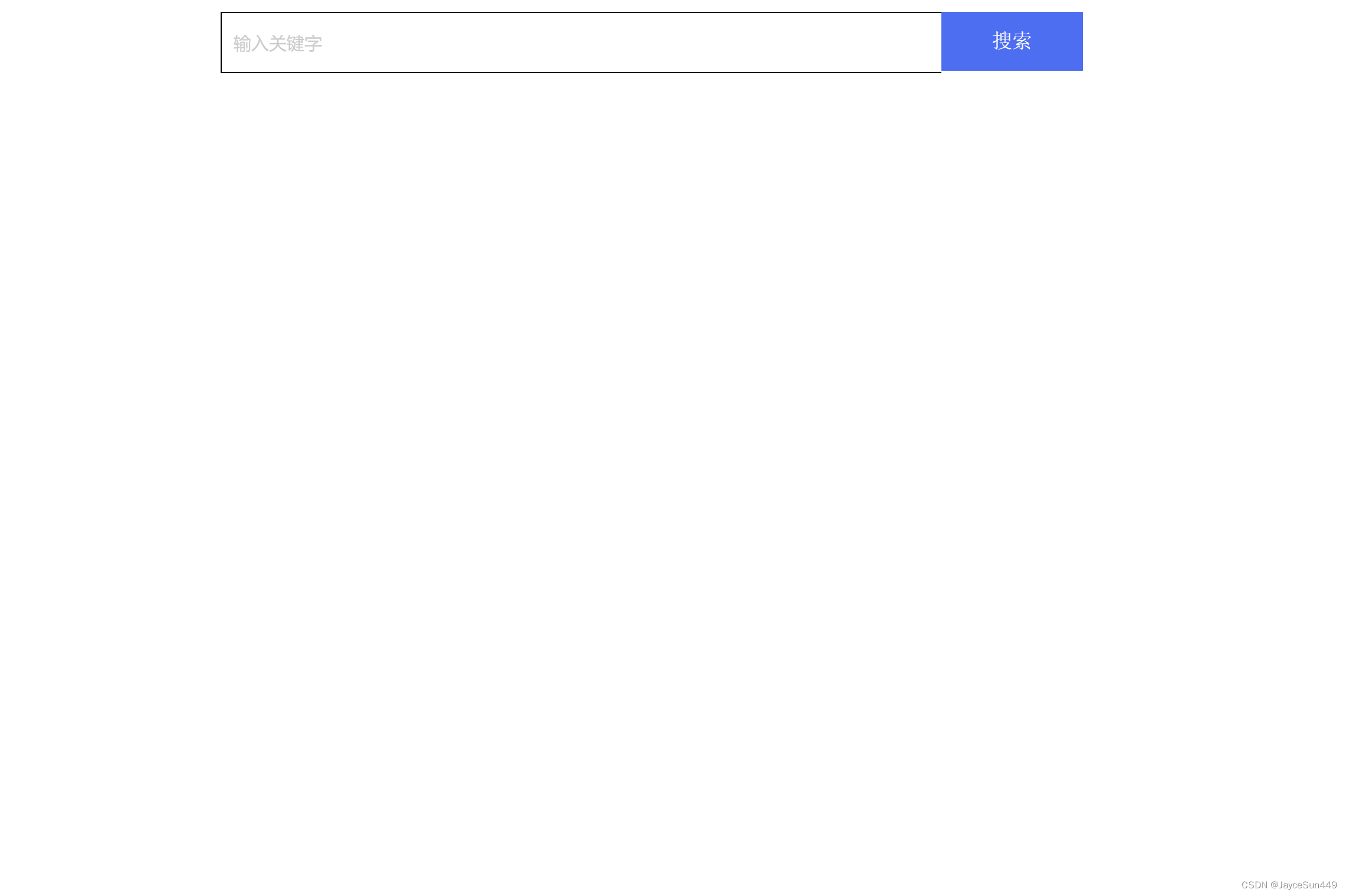
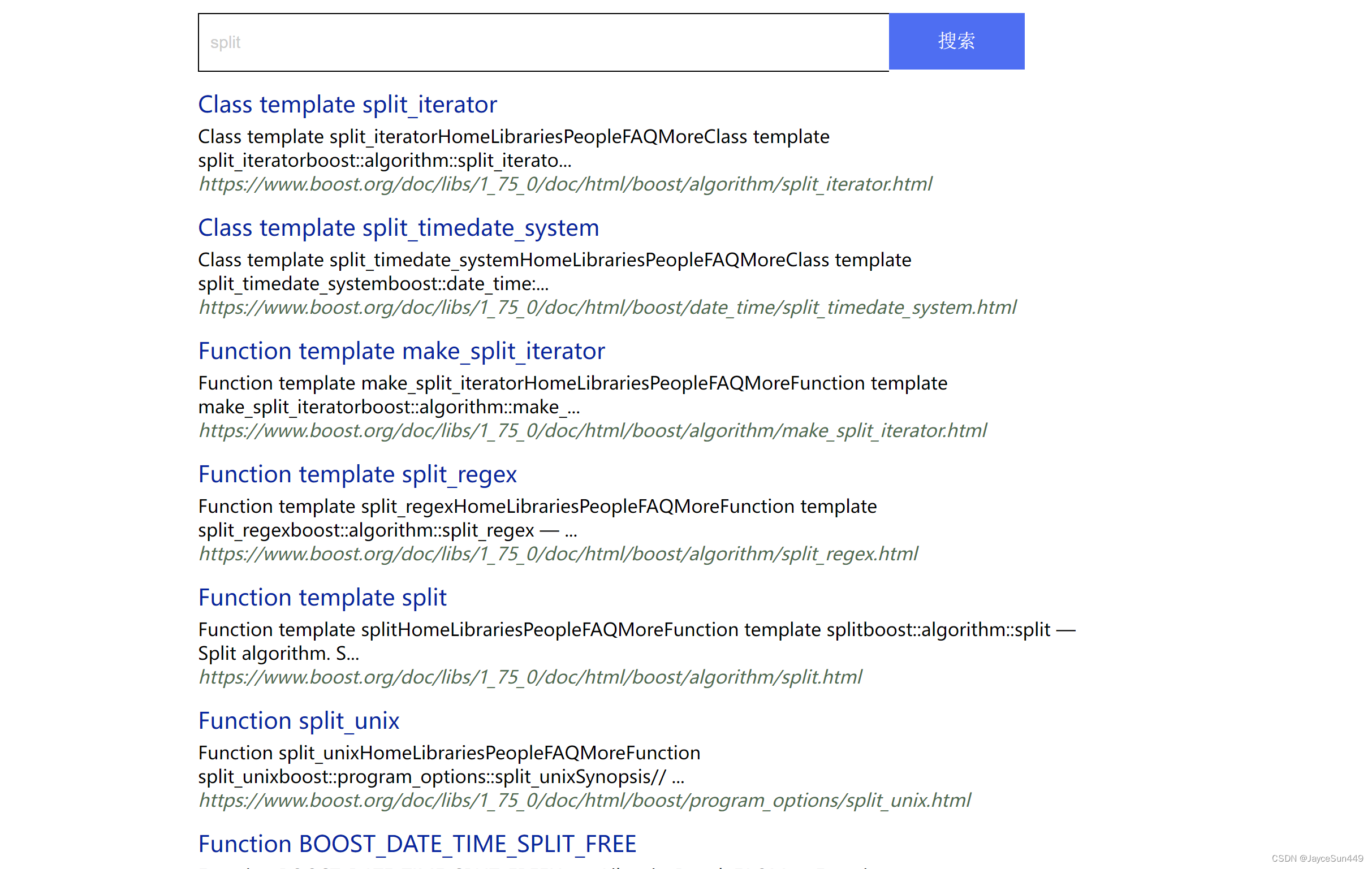






















 2万+
2万+











 被折叠的 条评论
为什么被折叠?
被折叠的 条评论
为什么被折叠?










